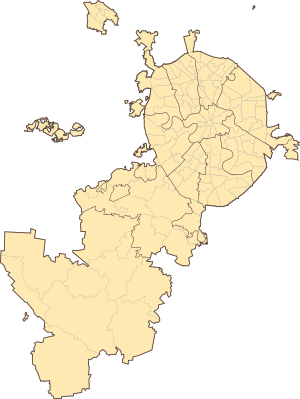Aqueduct in Rostokino
Coordinates: 55 ° 49 ′ 44 ″ N , 37 ° 39 ′ 20 ″ E
| Aqueduct in Rostokino | ||
|---|---|---|
| The aqueduct after the 2007 restoration | ||
| Official name | Росто́кинский акведу́к | |
| use | Aqueduct , pedestrians | |
| Subjugated | Jausa | |
| place | Moscow , Russia | |
| overall length | 356 m | |
| width | 15 m | |
| Number of openings | 21st | |
| Longest span | 8.5 m | |
| location | ||
|
|
||
The rostokino aqueduct ( Russian Ростокинский акведук ), even millions Bridge ( Russian Миллионный мост , transkr. Millionni most ) is a landmarked stone aqueduct from the 18th century in the northeastern county of Moscow ( Russia ), the first Moscow aqueduct over the river Jausa wore. The 356 meter long viaduct has 21 openings with a span of 8.5 meters and is up to 15 meters high.
location
The aqueduct is located in the Rostokino district not far from the Prospekt Mira arterial road , which then becomes Jaroslawler Chaussee ( M8 ). The footpath over the viaduct is in the extension of Jaroslawskaja uliza , which leads past the municipal hospital No. 40. The northern end is in a small park in which a museum of the Moscow water supply is planned.
history
In the 1770s, after Moscow was struck by the most devastating plague epidemic in its history and the need for a comprehensive water supply for hygienic reasons appeared urgent, Empress Catherine the Great initiated the construction of the first water supply for Moscow. The draft was worked out by the military engineer FW Bauer until 1780 . Construction work began in the same year, but was not completed until 1804 due to technical difficulties. The total construction cost was a good 1.6 million rubles . The aqueduct built as part of the aqueduct to bridge the Jausa was therefore popularly mocked as a million dollar bridge .
According to legend, during a pilgrimage to the Trinity Monastery of Sergiev Posad , Catherine was particularly impressed by the taste properties of the spring water there during a stopover in the northeastern Moscow suburb of Mytishchi and therefore insisted on the construction of a pipe from this place.
After its completion, the Rostokino aqueduct conducted water from Mytishchi to Moscow into the 20th century. It was not until the Soviet era that it lost its original meaning and was later used to lay district heating pipes . In 2007 the now dilapidated structure was restored, with a wooden roof structure over its entire course. The aqueduct is open to visitors on weekends and can be walked on.
Web links
- Rostokino Aqueduct : description on the official website of the North-Eastern Moscow District (Russian)
- Large photo gallery (Russian)
- Aqueduct in Rostokino. In: Structurae


